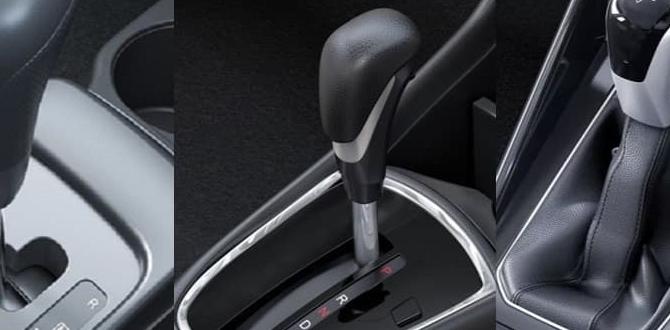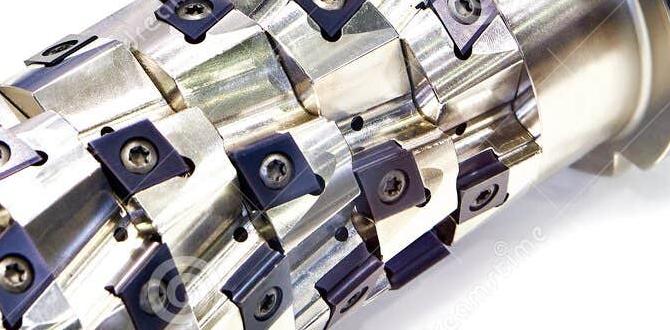Quick Summary:
Centering wood on a lathe is crucial for safety and precision. With the right techniques and tools, you can ensure your workpiece is perfectly aligned with the lathe’s axis, preventing wobbles and achieving smooth, accurate results. This guide covers the essential methods for beginners to master this fundamental skill.
Welcome to Lathe Hub! Ever struggled with wood that just won’t behave on the lathe? That frustrating wobble, the uneven cuts, or even bits of wood flying off – it’s a common problem for beginners. The good news is, most of these issues stem from one simple thing: not centering the wood properly. Getting your workpiece perfectly aligned is the bedrock of safe and successful lathe work. Without it, you’re fighting an uphill battle. But don’t worry, it’s a skill you can definitely master! We’ll walk through the proven techniques step-by-step, so you can stop fighting your lathe and start creating beautiful pieces with confidence. Let’s get your wood spinning true!
Why Centering Wood on a Lathe Matters: It’s More Than Just Aesthetics
When you first get started with a lathe, whether it’s for woodworking or even some light metalwork, the sheer number of techniques and tools can feel a little overwhelming. Among these, learning how to center wood on a lathe might seem like a basic, almost tedious step. But trust me, it’s one of the most vital skills you’ll ever develop in your workshop. Properly centering your wood isn’t just about making things look neat; it’s absolutely fundamental to safety, efficiency, and the quality of your finished project. Think of it like building a house – if the foundation isn’t level and square, the whole structure is compromised.
A workpiece that’s off-center will vibrate violently. This vibration is not only incredibly annoying, making it hard to get a clean cut, but it’s also dangerous. Loose, vibrating wood can easily catch on your tools, leading to tool kickback, which is a primary cause of lathe-related injuries. Imagine a small piece of wood chattering crazily while you’re trying to turn it down to a smooth cylinder. It’s a recipe for disaster. Beyond safety, an off-center piece means uneven material removal, making it nearly impossible to achieve symmetrical shapes or consistent wall thicknesses for bowls or hollow forms.
Furthermore, trying to work an unbalanced piece wastes your time and your wood. You’ll be fighting the lathe’s natural spinning motion, making your cuts rough and unpredictable. This often leads to frustration, discarded projects, and a dent in your confidence. Mastering how to center wood on a lathe, however, sets you up for success. It allows for smooth, controlled cuts, predictable material removal, and ultimately, a much more enjoyable and productive woodworking experience. Let’s break down the essential methods to get you there.
Understanding the Basics: What Does “Centered” Even Mean?
Before we dive into the “how,” let’s make sure we’re on the same page about the “what.” When we talk about centering wood on a lathe, we mean aligning the physical center of your workpiece perfectly with the rotational axis of the lathe. The lathe’s axis is determined by the headstock spindle (where the motor is) and the tailstock spindle (the part that typically moves in and out to support longer workpieces).
So, when your wood spins, it should rotate smoothly around this imaginary line, like a perfectly balanced wheel. If the wood isn’t centered, its center of mass will describe a circle around the lathe’s axis as it spins – that’s the wobble you feel and see. This wobble is what causes all the problems we discussed.
There are two main ways wood is mounted on a lathe for turning:
- Between Centers: This is common for spindle turning (like legs for furniture, chair spindles, or tool handles). You mount a relatively long, small-diameter piece of wood between a drive spur in the headstock and a live center (a bearing-mounted point) in the tailstock. Getting the wood centered here involves ensuring the points of the spur and center engage the wood’s axis.
- On a Faceplate or Chuck: This method is typically used for face-on turning, like bowls, platters, or other wide, shallow objects. A faceplate is a disk that screws onto the headstock spindle, and the wood is screwed or bolted to it. A chuck is a more versatile tool that grips the wood, often from the inside or outside. For these methods, centering involves ensuring that the wood’s rotational center aligns with the headstock spindle.
While the specific setup differs, the goal remains the same: a direct, coaxial relationship between the wood and the lathe’s spindle axis. We’ll cover both scenarios.
Essential Tools for Centering Wood
You don’t need a massive collection of specialized tools to get started with centering wood. Most of these are standard accessories for any lathe. Here are the key players:
- Lathe: Obviously! Make sure it’s in good working order.
- Drive Spur (or Drive Dog): This tool screws into the headstock spindle and has angled “teeth” or a cone shape that bites into the end of your wood. It transfers the rotational power from the lathe to the workpiece.
- Live Center: This fits into the tailstock quill and has a bearing-mounted point that rotates with the wood. It supports the end of the workpiece and allows it to spin freely without friction at that end.
- Tailstock: The movable part of the lathe that holds the live center and applies pressure to support the workpiece.
- Faceplate: A circular metal plate that screws onto the headstock spindle. You then attach your wood to this plate, usually with screws.
- Lathe Chuck: A more advanced tool that grips the outside diameter of a mounting spigot (for bowl jaws) or grips from the inside of a pre-drilled hole (for chuck jaws). Chucks offer great holding power and versatility.
- Wood Screw (for Faceplate Use): A strong screw to attach wood to a faceplate.
- Center Finder or Compass: A simple tool to help locate the center of irregular shapes. For square stock, it’s particularly useful.
- Measuring Tape or Rule: For initial workpiece preparation.
- Pencil: To mark the center.
- Safety Glasses: ALWAYS wear safety glasses.
- Dust Mask/Respirator: For fine wood dust.
- Hearing Protection: Lathes can be noisy.
Method 1: Centering Wood Between Centers (Spindle Turning)
This is the most common method for turning “spindles” – pieces that are longer than they are wide. Think chair legs, table legs, tool handles, and decorative spindles.
Step 1: Prepare Your Wood
Start with your rough lumber. If it’s square, you’ll need to make it roughly round (or at least octagonal) to ensure it spins without excessively throwing itself out of balance initially. This is sometimes called “breaking the corners.” You can do this with a hand saw, band saw, or even carefully with a block plane.
Using a tape measure and pencil, find and mark the center point on both ends of your workpiece. This is crucial. For a square piece, the easiest way to find the center is to draw diagonal lines from corner to corner on each end. Where the lines intersect is the center.
Step 2: Install the Drive Spur
Ensure your lathe is unplugged or powered off.
Screw the drive spur into the headstock spindle. Make sure it’s snug.
Locate the center mark on one end of your wood. Position this end of the wood against the drive spur so the spur can bite into it.
Engage the tailstock. Bring the tailstock quill forward until the live center just touches the center mark on the opposite end of the wood. Do NOT apply full pressure yet. The tailstock should be firmly locked in place, aligned with the headstock spindle.
Step 3: “Kiss” the Wood with the Live Center
This is a critical step for safety and achieving a good center.
With the lathe OFF, slowly rotate the workpiece by hand.
As you rotate, gently advance the tailstock quill to push the live center into the wood. You want the point of the live center to mark your wood.
The goal here is to create a deep enough impression on the wood for the live center to engage securely without crushing the wood or the center point. You don’t want it to be too shallow (it will slip) or too deep (it can split the wood).
Step 4: Apply Tailstock Pressure and Create a “Witness Mark”
Once you have a solid mark from the live center, you might need to adjust the tailstock.
Advance the tailstock quill again, applying firm pressure. You want the wood to be held snugly between the drive spur and the live center. It should be tight enough not to wobble, but not so tight that it stresses the wood excessively. A common recommendation is to crank the tailstock wheel until the wood is snug, then give it perhaps a quarter to a half-turn more. You can often feel the resistance change as it gets tight.
Now, with the tailstock locked, turn the lathe ON at its LOWEST speed setting.
Slowly rotate the headstock by hand again. The rotating live center should be cutting a clean, circular groove at the exact center of the end of your wood. This is your “witness mark.”
Step 5: Check for True Centering
Turn the lathe OFF.
Examine the witness mark. It should be a perfectly centered circle. If it looks like an oval or is significantly off-center, you need to reposition.
Step 6: Adjusting if Off-Center
If the witness mark is off, you’ll need to reposition the wood on the drive spur.
Loosen the tailstock and retract the live center.
The wood is likely not seated properly on the drive spur. You may need to wiggle it or reposition it slightly on the spur’s biting surface.
It’s very important that the live center is also aligned with the center of the wood. If the wood is very irregular or the center mark isn’t perfect, the live center might not be tracking true. Sometimes, you might need to use a parting tool to face off the end of your wood to create a new, clean center point for the live center to engage.
After repositioning, repeat steps 3 through 5. Be patient! It might take a few tries to get the wood seated perfectly on the drive spur. The goal is for the witness mark to be a clean, centered circle, indicating the live center is spinning precisely on the wood’s axis.
Step 7: Lock in and Increase Speed
Once you have a perfect witness mark, re-engage the tailstock with firm pressure. Lock the tailstock in place.
You can now gradually increase the lathe speed to your desired turning speed, listening and watching for any signs of vibration. A little initial vibration is normal as you start turning, but it should smooth out as you true up the wood.
A key resource for understanding lathe safety, including tool setup, is the OSHA standard for woodworking machinery, which often applies to the principles of safe operation on any powered tool. Always consult your machine’s manual and local safety guidelines.
Method 2: Centering Wood on a Faceplate (Bowl/Face-On Turning)
This method is used for turning pieces that are wider than they are long, like bowls, platters, or clock faces. The wood is mounted face-on to the headstock spindle.
Step 1: Prepare the Wood and Faceplate
Start with your disk of wood. For a bowl blank, you typically want it slightly larger than your intended finished bowl.
You need to attach the wood securely to the faceplate. There are a few common ways to do this:
- Screwing Directly: This is the most common for beginner bowl turning. Find the center of your wood blank (using diagonals on a square blank, or measuring on a pre-cut circle).
Drill pilot holes in the wood that correspond to the screw holes on your faceplate. It’s often best to use at least four screws, evenly spaced.
Place the wood blank over the faceplate so the pilot holes align with the faceplate holes.
Insert appropriate wood screws through the faceplate holes and into the wood. Use screws that are long enough to get a good grip but not so long that they poke through to the intended inside surface of your bowl. Tighten them securely. - Using a Screw on Center: For smaller or lighter work, some faceplates have a central screw hole. You can drill a clearance hole through your wood blank and then screw the wood directly to the faceplate, using a strong bolt or screw that passes through both.
- Tenon and Recess: More advanced methods involve creating a small tenon (a cylindrical protrusion) on the back of your wood blank that fits into a recess in the faceplate, or vice versa. This is beyond basic centering but is important for secure chucking later.
Step 2: Install the Faceplate with Wood on the Lathe
Ensure the lathe is unplugged or powered off.
Thread the faceplate (with the wood blank attached) onto the headstock spindle. Make sure it’s screwed on fully and is snug. You might need a wrench to tighten it.
If you are using a tailstock for support (e.g., for a large, rough piece), bring the tailstock into position and engage the live center into its initial mark on the edge of the wood blank, or onto a pre-drilled center point if you made one. For initial shaping, you might only need the faceplate and headstock.
Step 3: Rough Trimming and Checking Center
If you’ve just mounted a square or irregular piece of wood, it’s going to be severely out of balance.
Turn the lathe ON to its LOWEST speed setting.
Stand well back. The wood will likely vibrate quite a bit.
As it spins, you will see the high spots. If you are using the tailstock for support, you can slowly advance the tailstock to add extra support for this initial roughing out.
Your first goal is to turn the outer edges of the wood into a reasonably round shape. This will reduce the violent vibration. You can use a gouge or a roughing gouge for this.
The critical part of centering here is that the faceplate creates the rotational axis. As long as the faceplate is screwed onto the headstock spindle correctly, and the wood is screwed to the faceplate such that its center aligns with the center of the faceplate, the wood will run true. The main challenge is getting the initial attachment right.
Step 4: Refining the Shape and Ensuring True Running
Once the outer edge is roughly round, you can increase the lathe speed slightly.
Continue to refine the outer shape, making it more circular. As the wood becomes more balanced, the vibration will decrease.
When you turn the outside of a bowl, you are essentially creating a consistent radius from the center. If your wood blank was accurately centered and attached to the faceplate with its own center aligned with the faceplate’s center, your turning will naturally be centered.
Step 5: Dealing with Off-Center Attachments
What happens if you realize your wood isn’t centered on the faceplate? This usually means the screw holes weren’t drilled perfectly, or the initial center mark on the wood was off, and you attached the faceplate at an angle relative to the wood’s true center.
If the imbalance is severe, you may need to pause the lathe, loosen the wood-to-faceplate screws, carefully reposition the wood to better align its center with the faceplate’s center, and re-tighten. This is why using a pilot hole or a “center finder” for attaching wood to faceplates is so useful.
For very accurate work, some woodturners face off the front of the blank on the lathe first, then drill a center pilot hole, and then reattach it to the faceplate using this reliable center hole and screws. This effectively re-centers it.
Step 6: Transitioning to a Chuck (Optional but Recommended)
Many advanced woodturners move from faceplates to using a chuck for bowl turning. A chuck grips the wood automatically, and you can often re-mount the bowl’s exterior and interior using precise jaw settings that ensure perfect centering. Creating a “chuck jaw recess” or a “tenon” on the back of the bowl allows you to grip it securely and centrally in a four-jaw chuck, a setup that offers immense stability for hollowing.
A good reference for safe woodworking practices includes resources like the Wood Magazine safety tips, which cover common hazards and preventative measures. Always prioritize safety.





